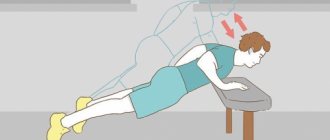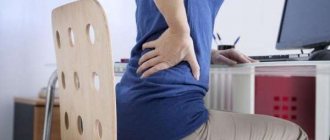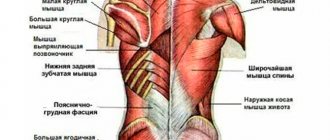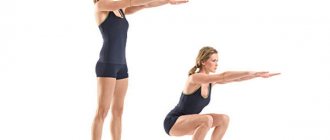The causes of pain in the lumbar spine can be different. These include pathological changes in the spinal column (osteochondrosis), dystrophic changes in the muscle system of the back area. Among all the possible ways to combat this disease, we will analyze in detail which exercises will help with lower back pain.
Incorrect movement, often sudden, can also lead to pain, when a nerve is pinched, which further contributes to the appearance of painful sensations.
Benefits of Exercise
Physical activity is one of the first places in activities aimed at eliminating back pain. This type of therapeutic effect occurs in different ways and has its advantages:
- Exercises for the lumbar spine help stretch and relax smooth muscles.
- Regular muscle work will help strengthen and restore the entire lumbar spine. This affects not only the etiology of the pain syndrome, but also the general condition of the person.
- During physical activity, blood circulation in the circulatory system increases. This helps to improve the absorption of nutrients into the joint apparatus, vertebrae, as well as restore the function of intervertebral structures.
Before starting a training complex, it is recommended to consult a doctor for possible contraindications and concomitant pathologies.
Let's consider Dr. Evdokimenko's recommendations on gymnastics for exacerbation of disc herniation or lumbar osteochondrosis. These exercises are also suitable for treating lumbar pain or shooting from the lower back to the leg.
Self-medication can seriously harm your health, so you should not engage in inappropriate exercises. The correct selection of a training set is important.
The role of exercise therapy for the treatment of back pain
Often, for back pain, especially if its cause is pathological changes in the spinal column, conservative treatment methods based on the use of non-steroidal anti-inflammatory drugs are used. At the same time, the leading role is given to physical therapy exercises.
What are the benefits of therapeutic exercises for back pain?
Firstly, physical activity helps maintain the smooth muscles of the spine, returning the active shape of the back, which makes it easier to endure everyday activities.
- Strengthened muscles and ligaments prevent displacement of the vertebrae during awkward or sudden movement of the body, lifting heavy objects, and prevent the occurrence of various injuries.
- Moderate physical exercise helps normalize metabolic processes in the body. This improves the absorption of vitamins and nutrients necessary for bone and cartilage tissue.
In people leading a sluggish, sedentary lifestyle, metabolic processes are primarily disrupted, which subsequently leads to the development of pathologies of the musculoskeletal system.
Physical therapy exercises bring a variety of benefits to the body:
- With the help of training, circulatory circulation is normalized and the flow of oxygen to tissues improves.
- The load on the spinal discs is reduced due to the expansion of the space between the vertebrae.
- Smooth muscle spasm occurs.
- Performance increases.
- Pinched nerve endings are eliminated, followed by the disappearance of pain.
Therapeutic gymnastics can be practiced not only in hospitals or specialized institutions. A home environment won’t hurt to do the exercises; the main thing here is the right training complex.
Why is it important to do these exercises?
Dikul’s exercises for back pain, as well as physical therapy according to the systems of other authors, are prescribed by specialists for diseases of the musculoskeletal system and spine because they have a pronounced positive effect. However, there is one contraindication for carrying out the measures - the acute course of the disease. As soon as the exacerbation is relieved, the doctor prescribes therapeutic exercises, which have the following positive effect:
- Strengthens the muscular frame, as a result of which parts of the musculoskeletal system are more firmly fixed in their places - no pinching or displacement occurs;
- Strengthened muscles are less likely to experience spasm, hyperptonus under significant loads/hypodynamia - now such conditions are less likely to cause discomfort;
- Spasms and muscle hypertonicity are relieved, pain and pinched nerve tissue go away;
- Over time, flexibility and mobility of the affected parts of the spine are restored.
This is only true if the patient does exercises for pain in the lumbar region recommended by the doctor. Unauthorized prescription of your preferred complex can have a negative impact on the musculoskeletal system, worsen your well-being, and accelerate the development of the problem.
Exercises to Reduce Back Pain
The next complex is primarily aimed at reducing pain in the back and is carried out slowly, measuredly, and breathing should remain free.
(1) - Gluteal bridge
Take a lying position on your back on the floor, with your legs bent at the knees. Lift your pelvis up and freeze in this state for a few seconds. Exhale as much as possible, slowly lowering to the original position.
(2) - Boat
Bodymaster.ru recommends Fitness Trainers:
Roll over onto the front abdominal wall, stretch your arms along your body, palms up. Raise your head, shoulders and lower limbs at the same time. Your torso should be similar to a boat shape. This exercise helps eliminate pain in the sacrolumbar spine.
(3) - Stretching the back flexors
Now lie down on your back. The left leg must be bent at the knee, pulling it with your hands towards the chest area. The same should be repeated with the right leg. Then, you need to pull both limbs towards your chest. In this position, you should freeze for a few seconds, slowly, rocking on your back.
(4) - Back stretch
Take a chair and sit on it. Grasp its lower edge with your hands, and pressing tightly, bend forward and backward. This movement will eliminate congestion in the back, improving circulatory circulation. This exercise is useful for people who spend a lot of time sitting in the office.
(5) - Back warm-up
Take a knee-elbow position. Smoothly lower yourself onto your buttocks until they touch your heels. You must repeat the exercise 7 times.
Gymnastics to prevent lower back spasms
To prevent muscle spasms in the lumbar spine, perform physical therapy. See also: how to stretch your lower back exercises. By regularly performing exercises, you will learn to relax your muscles, maintain an even posture, and maintain body flexibility for a long time. It is better to do the complex daily, in the morning, half an hour after waking up, or in the evening, an hour before bedtime.
Prepare a practice mat and comfortable clothes that do not restrict movement. To engage one or the other muscle groups periodically, for example every three days, change the complexes. Monitor your workload yourself, assess your own condition, and make entries in your diary.
Watch a description of an effective series of lower back relaxation exercises.
Complex No. 1
Exercise 1. Stand with your feet shoulder-width apart. Exhaling, bend forward and try to touch the floor with your fingers. Take your starting position. Keep your legs straight, make smooth, slow movements. Perform 6-8 repetitions.
Exercise 2. Place your feet shoulder-width apart. Gently lean to the left, sliding your hand down the outside of your thigh. Leaning as low as possible, hold for twenty counts. Repeat on the right side.
Exercise 3. Place your feet together. As you exhale, squat on your toes, bend your torso, neck and head forward. Press your chest to your hips, clasp your knees with your hands. Slowly stand up, exhale, take your starting position. Complete eight reps.
Exercise 4. Stand up straight. Exhaling, pull your right leg bent at the knee to your chest, clasp your shin with your hands, press your thigh to your stomach. Inhale and take the starting position. Repeat with the other leg. Do 10 repetitions in total.
Exercise 5. Lie on your back, place your arms loosely along your body. Throw your right leg bent at the knee over your left. Keep your lumbar back straight. Hold, count to 20. Repeat with the other leg. Perform 5 repetitions on each side.
If you need to relax your lower back, then any spinal stretching exercises will do. Take this complex as a basis, periodically supplement it, add new items.
Complex No. 2
Perform the lower back relaxation series while lying on your back. Do a five-minute warm-up first, swing your arms, take energetic steps, bend over, and turn.
- Place your arms by your sides, palms up. As you exhale, bend your legs, press your knees tightly to your chest, and while inhaling, return to the starting position. Perform 8-10 repetitions.
- Place your hands on your chest. Exhaling slowly, sit down, try to do this without using your hands. As you inhale, take the starting position. Do everything very slowly, without jerking, 5-6 times.
- Place your hands behind your head, clasp your palms. Raise your straight legs up to a right angle. Breathe freely and evenly. Press your head, shoulders and elbows firmly to the floor. Take your starting position. Perform 4-6 approaches.
- Extend your arms along your body, palms facing down. Sit down slowly, stretch your arms forward, try to reach your toes with your hands, and bring your forehead as close to your knees as possible. Breathe freely and measuredly. Repeat 3 to 6 times.
- Get on your knees, raise your arms up. Slowly lower yourself forward. Try to relax and stretch your spine as much as possible. Stay in this position for 1 minute to two.
Back complex from Dr. Bubnovsky
There are a number of training methods developed by Dr. Bubnovsky. The exercises are aimed at eliminating pain in the back and lumbar region.
(1) - Walking on all fours
A physical activity that has shown good results is walking on all fours. Use it as a warm-up.
(2) - Raising legs from a lying position
Option A. Take a lying position and relax. The legs should be bent at the knees and the hands should be clasped behind the head. You should prepare a cold compress in advance by placing it under the lumbar region. At the same time, press your head to your chest (twisting) and tighten your lower limbs. At the same time, your elbows should touch your knees.
Option B. Place your hands freely along the body. Bend your legs alternately at the knee joint. Also use a cold compress, placing it under the lumbar region.
| (3) — Tilts to the sides Take a vertical position, spread your legs shoulder-width apart. Now you should lower yourself to your left and right legs, leaving your back straight without bending. You should also not bend your knees. |
| (4) - Hanging knee raises on the bar Hang from the horizontal bar. Bend your knees, lifting them towards your chest. More trained people raise their legs forward. |
Exercise during flare-ups
Proper physical activity will help even during periods of exacerbation of pain. The intensity of the exercises should be minimal, otherwise there is a high probability of worsening the patient's condition, and the back muscles can be easily injured. Medical gymnastics provides a number of safe techniques that can be performed in case of severe pain.
(1) — Warm-up
You need to lie down on a hard surface. This could be a bed or a couch. Lower your legs down to a hanging position. Take five deep breaths slowly. Then, carefully, slowly, lift your torso.
(2) - Voltage
Take a knee-elbow position. It is necessary to take a measured, long breath, and then exhale the air. The buttocks should be tensed, remaining in this position for several seconds. Now relax and repeat the exercise 5 times.
Relieving acute pain
With weakened, insufficiently strong back muscles, lumbodynia may periodically appear, as a sharp acute pain in the lumbar region. Simple but effective therapeutic exercises can help cope with pain.
(1) - Tilts
You need to kneel down. Place a chair in front of you for support. You need to put both hands on the chair and arch your back as much as possible up, and then also down. It is recommended to perform up to 10 approaches of the exercise.
(2) - Cat/Cow
Take a kneeling position. You should rest your head and arms on a chair, making slow movements from right to left, while arching your back.
Take a position on all fours, slowly arch your back like a cat, and then arch it, trying to inflate your hump like a camel. This movement is also effective for acute back pain.
All therapeutic sets of exercises formed according to the principle of medical gymnastics must be carried out smoothly and measuredly so as not to harm the patient’s condition and eliminate pain in the back.
If pinched
When the vertebrae are pinched, acute pain occurs. A therapeutic complex aimed at separating the intervertebral space can help cope with pain.
(1) — Hanging on the bar
A fixed door or training bar is available as additional equipment. It is necessary to hang evenly on the bar, remaining in this position for 60 seconds, completely relaxing the muscles, without making any other movements. The exercise should be repeated after 10 minutes, doing three approaches a day.
(2) — Hanging side crunches
It is necessary to hang on the horizontal bar with straight arms, making turning movements from side to side. When performing the movement, the body must be completely relaxed.
Causes of lower back pain
The most common causes of lower back pain are:
- Staying in one position for a long time causes the muscles to tense and cause unpleasant discomfort.
- Due to insufficiently strong muscles that are not able to keep the vertebrae from putting excessive pressure on the intervertebral disc. As a result, the latter becomes deformed and puts pressure on the nerve, causing pain.
- Osteochondrosis and other lower back diseases, due to which blood circulation and metabolism deteriorate. This affects cellular metabolism, thanks to which the tissues of the vertebrae and discs receive the necessary nutrients and moisture. Since this process is disrupted, their functioning is also disrupted, which provokes pain, as well as scoliosis, hernia and other pathologies.
- Overweight. You can read how to choose bathroom scales for weight monitoring in the article on our website.
Back exercises for lower back pain are a kind of healing elixir that helps fight all three of the above causes and provides the following actions:
- Exercise helps stretch and relax muscles, which helps relieve pain.
- Daily exercises help strengthen the muscle corset, increase the distance between the vertebrae, reduce pressure on the discs and thus release the pinched nerve.
- Exercise promotes better blood flow to the muscles, improves cellular nutrition of the discs and vertebrae, which helps stop degenerative processes.
Just 15-20 minutes and you can significantly improve your own health. But keep in mind that exercises for lower back pain should be selected taking into account the cause of the pain. Therefore, consultation with a specialist and correct diagnosis are necessary, because, for example, with scoliosis, exercises should be aimed at straightening, and with hernia and osteochondrosis, at stretching. Like medications, the complex must be selected individually in each case.
The sooner you begin to treat lower back pain, the higher the likelihood that you will be able to avoid negative consequences and prevent the progression of the disease.
To ensure that exercises for back and lower back pain are as effective and safe as possible, follow these recommendations:
- Perform the exercises smoothly, without sudden movements, using all muscle groups gradually.
- Stop training immediately if you experience increased lower back pain, dizziness, or other unpleasant symptoms.
- Work out in clothes made of lightweight, breathable materials that will not hinder your movements.
- Exercise in a room at room temperature with the windows closed to avoid colds in your lower back.
- It is important to breathe properly while doing the exercises. The least effort is made on inhalation, the greatest on exhalation. There is no need to hold your breath.
- Start with minimal loads and increase them gradually as your fitness increases.
How to warm up your muscles
Before starting any training complex, it is necessary to do a warm-up, which will warm up the muscles and prepare the joint apparatus for the exercises.
Pelvic rotations. Take an upright position with your feet shoulder-width apart. Place your palms on the lumbar region. Make circular movements to the right and left. Should be repeated several times.
Lateral bends help stretch muscle fibers. Take a vertical position, clasp your palms, leaning toward your left and right feet in turn. In a bent position, place your palms on the floor, between your feet, and hold for five seconds. Slowly and smoothly return to the starting position.
Take a supine position on your chest . Extend your arms behind your head. Raise your upper body using your back muscles. Fix the maximum position and lie on the anterior abdominal wall. It is necessary to repeat the exercise, slowly, 8 times.
How the workouts work
With a correctly formulated therapeutic-physical complex:
- Smooth muscles relax, stretch, and pain disappears.
- Blood circulation in the lumbar spine improves, helping to normalize the flow of nutrients to the spine.
- All muscle groups of the back are strengthened, the intervertebral space expands, from where the pinched nerve is released.
To improve the quality of life and overall well-being, it is recommended to carry out treatment activities regularly, without skipping.
When to see a doctor
Pain syndrome can be caused by a number of serious reasons. Before starting exercises, you should consult a doctor to clarify the pathology. An appointment with a doctor is required if:
- The pain does not go away for several weeks.
- When the body moves, a crunching sound is heard in the lumbar region.
- Inability to fully carry out movements due to pain.
- The pain syndrome is accompanied by headache, weakness, nausea, dizziness, and numbness of the extremities.
Types of exercises
All exercises can be performed in different positions (standing or lying down), as well as using special equipment in the form of a gymnastic ball, jump rope or expander. But regardless of the type of exercise or its complexity, all movements should be smooth and the workout should be slow. This will avoid various injuries.
Lying down
It is worth noting that stretching the intervertebral discs can reduce the load placed on them. But when performing the exercises listed below, you should avoid applying compression to your lower back.
Table. Exercises for the lower back in a lying position.
| Exercise number, photo | Execution Features |
| No1 | In a lying position, place your hands near your chest, first bending them at the elbows. Slowly make a half-bridge with your chest, stretching it up, and then lower it just as slowly. At the top point you need to linger for 1-2 seconds. Repeat the exercise 6 times. |
| No2 | Lie on your back, keeping your arms along your torso. Bend your knees and, pressing them towards your buttocks, lift your pelvis up. In the upper position of the pelvis, you should feel the muscles of your back and buttocks contracting. Then slowly lower yourself down. For the best effect, it is recommended to perform the exercise at least 6 times. |
| No3 | The position remains the same - lying with your back on the floor. The arms should be along the body, palms down, and the legs should be straightened. Try to lift your body above the floor using your shoulders and palms (do not lift your arms). The movement should be carried out by the spinal muscles. Repeat the exercise 5 times. |
| No4 | In a lying position, simultaneously raise your right leg and arm and, holding in this position for 1-2 seconds, slowly return to the starting position. Then do the same operation, but with the left leg and arm. The exercise must be repeated 8 times. |
| No5 | Lie on your stomach and press your hands to your ears. In this position, you need to lift the upper half of your body up and, after holding for a few seconds, slowly return to the starting position. In this exercise, which is recommended to be repeated at least 6 times, the spinal muscles are maximally involved, especially in the lumbar region. |
Prices for mats for yoga and fitness
Regular performance of these exercises helps improve blood flow in the lumbar region, due to which the vertebrae receive a sufficient amount of nutrients. That is, with the help of such charging, stagnant processes can be eliminated.
Exercises while standing
It is worth immediately noting that all therapeutic exercises performed in a standing position are more complex, so they should be resorted to in the absence of pathologies that hinder movement. One of the most popular exercises is the “ballerina pose ,” in which you need to keep your body balanced while standing on your toes. Also here you need to alternate standing on your toes and on your heels. Regularly performing this exercise will not only relieve tension from the spine, but also prevent varicose veins.
Maintain your balance while standing on your toes
Pelvic rotation is another exercise that can help with lower back pain. Many people met him during their school years in physical education classes. Stand straight, hands on your waist, and feet shoulder-width apart. In this position, rotate your pelvis clockwise and then in the opposite direction. It is recommended to repeat the movement 10 times in each direction. Movement must be slow and careful.
Pelvic rotation
There is another exercise for the lower back that is performed in a standing position. To do this, you need to lean your back against a flat wall, preferably without baseboards. Make sure your heels, pelvis, back of your head and shoulder blades touch the wall. In this position, correct posture is formed. Stand still for 3 minutes, increasing the time by 1 minute daily. Thus, you need to reach 10 minutes. The fact is that your posture will correct itself and become normal thanks to muscle memory.
Wall stand for posture
On a note! In parallel with therapeutic exercises, due attention should be paid to the abdominal muscles. If you only train your back, this can negatively affect your posture (the back and abdominal muscles are antagonists), so for balance you need to also train your abs. Consequently, with weak spinal muscles, a person begins to slouch, and with weak abdominal muscles, the back begins to pull the body towards itself.
Exercises to strengthen your back
Many patients tend to perform exercises for the lumbar spine without leaving home. To eliminate and prevent unpleasant sensations in the sacral-lumbar zone, a set of therapeutic measures has been created that can easily be carried out at home:
(1) — Forward bends
Take a sitting position on the floor, bending one leg at the knee, moving it to the side. The other leg is straight. It is necessary to reach for the fingers of the straight limb, slowly and smoothly. After performing 10 times, the leg should be changed and repeated.
(2) - Lunges
To perform the exercise, take a vertical position, arms along the body, legs slightly wider than shoulders. Now you need to slowly lower yourself down, putting one leg forward, bending it at the knee. The back remains as straight as possible. It is necessary to perform lunges 10 times, then the position of the legs changes and the movement is repeated. This exercise for the sacral region of the spine eliminates pain and improves circulatory blood flow.
(3) — Scissors
Take a lying position on your back, lifting your legs one at a time, trying to pull as high as possible. It is recommended to perform at least 3-4 sets of 15-20 repetitions.
Abs Exercise - Sit-ups
The method of removing excessive tone from the spine is to strengthen the muscles of the anterior abdominal wall. The abs are directly connected to the lumbar spine, forming the anterior muscle corset.
To do the exercise, you need to lie on your back, cross your arms at your chest or behind your head. Raise your body, trying not to bend your arms; only the rectus abdominis muscles should be used. The neck is completely relaxed, do not put pressure on it with your hands. The exercise helps strengthen the muscles of the anterior abdominal wall, as well as the lumbar spine.
A set of pain-relieving exercises for the lumbar spine
Use this set of pain-relieving exercises for the lumbar spine in case of exacerbation of symptoms, in case of restrictions on physical activity.
- The initial pose is lying face up. The patient performs slow, long inhalations and exhalations. Legs can be slightly raised, lean on a wall, chair;
- Repeat the breathing exercises, but in a different starting position - lying with your chest on a flat horizontal surface from which your legs hang. Take 5-7 deep breaths;
- Do gymnastics, but take a knee-elbow position with emphasis on your palms and knees.
Gymnastics is not capable of causing harm, but it can have an effective effect on nervous tissue. During the exercises, compression disappears and pain disappears.
Complexes for strengthening the back of beginners
Physical fitness is individual for everyone, it all depends on age, weight, and concomitant diseases.
That is why specialists in the field of medical physical education have created training complexes for back pain for beginners:
| (1) Heel position. Inhaling deeply, you should rise and spread your arms. Lower slowly, while exhaling. | |
| (2) To strengthen the anterior abdominal wall. Lie on your back, with your legs bent at the knees. We lift the body with a turn to the right. Then, change position and repeat. | |
| (3) Lie on your side, fix your arm in support on the floor. Swing your leg, freezing for a few seconds halfway through. Then, change position. | |
| (4) Take a kneeling position, making swaying movements from side to side. | |
| (5) Lie on your stomach and lift your legs off the floor one by one. | |
| (6) Lie on your stomach and alternately lift your body off the floor. | |
| (7) Knee push-ups. Partial push-ups should be performed. | |
| (8) Take a position on all fours, alternately swinging your legs up and down. |
You can also consider a simpler set of 3 exercises:
Contraindications to gymnastics
Therapeutic exercises cannot always relieve and eliminate pain in the lumbar region. Physical training is contraindicated for lumbar injuries, kidney pain, herniated discs, and various tumors.
When there are indications for performing therapeutic exercises, you should take a comprehensive approach: perform exercises not only to relieve pain, but also to prevent it.
How to relax your back muscles during pregnancy
Almost every pregnant woman experiences back pain during pregnancy.
The reason is an involuntary change in posture under the weight of a growing belly.
It is useful to visit the sauna from time to time
Often, without noticing it, we allow the lower back to sag forward, which causes the muscles of the lumbar region to become compressed and overextended.
In addition, during pregnancy the breasts noticeably enlarge, and their weight often begins to be reflected in pain in the thoracic region of the back.
Yoga for pregnant girls
A universal way to relax your whole body without the risk of harming yourself or your baby is yoga classes for pregnant women under the guidance of an experienced instructor.
If you can’t enroll in a yoga group for pregnant women, try to learn a simple pose on your own to relax the lumbar area of your back - child’s pose.
- Kneel on the floor with your legs spread wide.
- Sit on your heels and slowly lean forward, pressing your chin to your chest and stretching your arms forward.
- The forehead, forearms and elbows should touch the floor. The stomach fits freely between the knees.
- If your stomach is in the way and doesn’t fit between your knees, spread your legs wider. Stay in this pose for 20-50 seconds.
- Breathe evenly and freely. Then slowly return to the starting position.
Child's Pose
By repeating this simple exercise regularly, you can successfully combat back tightness and the pain that arises from it.
"Angry cat"
A good exercise to relax your back muscles is the “angry cat” exercise.
- Starting position: standing on your hands (hands) and knees.
- Smoothly lower your head down and round your back (like an angry cat - in an arch). Stay in this position for a few seconds without stopping your breathing.
- Then slowly return to the starting position. Repeat several times, but do not get yourself tired.
“Evil cat” exercises are ideal for pregnant women
Swimming and water aerobics
Swimming and water aerobics for pregnant women give excellent results. If you have the opportunity, be sure to sign up for such classes.
If there are no groups in your city, go to a regular pool and just swim for fun.
Swimming can help pregnant women cope with back pain
Comfortable sleep
To avoid feeling groggy in the morning, take care of a comfortable position while sleeping.
Sleep on your side, with additional pillows in places where you lack them.
You don’t have to buy a special bolster pillow for pregnant women, but if you have one, use it, it actually helps a lot.
Or take two or three small pillows and roll up a blanket of the thickness you need. The effect will be the same.
During pregnancy, pay special attention to proper sleep
Maternity bandage
If you walk a lot during the day or rarely have time to sit down and lie down to rest, wearing a bandage will be useful.
A high-quality bandage helps prevent the appearance of stretch marks and provides significant support for the abdomen.
Just note that you need to put it on correctly - from a position lying on your back, and not standing or sitting. A maternity brace will help support your back
A maternity brace will help support your back
You will find some more useful exercises for back pain in this article.
And remember: you need to exercise regularly. Episodic “bursts of activity” will not give even a small fraction of the effect that you will get by doing 15-20 minutes every day.
Level 1 - Exercises and Stretches for Low Back Pain
A sedentary lifestyle, accidental injuries, and prolonged standing can lead to sprain or rupture of the ligamentous apparatus of the muscles that fix the lower back. In this case, therapeutic exercises that can be easily performed outside of medical facilities can help.
1 - Cat/Cow pose
Exercise will help relieve muscle tension and also eliminate pain in the lumbar spine.
It is advisable to perform the movement on a sports mat or rug.
- Take a position on all fours, your back remains straight, your feet are brought together. Elbows parallel to shoulders.
— Taking a deep breath, arch your back, looking up.
- During the inhalation phase, pull in your stomach, round your back, and lower your head down.
Repeat the movement for 3 sets of 8 reps.
2 - child's pose
A therapeutic exercise – child’s pose – helps relieve lower back pain and relax smooth muscles.
- You need to sit on your knees with your legs spread wide. Bring your toes together and extend your arms, leaning forward. The frontal part of the head should rest on the mat.
- Don't stop breathing. Count to 15 and take the starting position.
- Repeat the movement 2 times for 3-4 approaches.
3 - hip flexor stretch
The exercise activates circulatory circulation in the lower back, pain disappears, and the muscular system relaxes.
- Take an upright position and step forward with your right foot. As you lunge, place your left shin on the floor. Straighten your shoulders, keeping your back straight and your hands on your right knee.
- You need to tense your gluteal muscles and abs, stay in the position for 10 seconds.
- Change the position of your legs and repeat the exercise.
- It is recommended to perform 4 repetitions of 3-4 sets on each leg.
4 - shell stretcher
Stretching is useful for aching pain. Exercise increases blood flow, expands the intervertebral space, eliminating pain.
Take a tabletop position and lower yourself onto your heels.
Your arms should be extended forward, palms down on the floor.
At the same time, your forehead needs to touch the mat.
Inhale and exhale until you feel the tension in your lower back. Relax completely.
It is necessary to repeat 2 exercises in two approaches.
How to forget about back and joint pain
Performing exercises or exercises for the lumbar spine is mandatory for almost all patients who suffer from pain in this area of the back.
This is especially true for those who usually ignore physical exercise and are forced to limit physical activity due to work.
The fact is that the skeleton in the lumbar region is most often subject to injury, and there is no additional protection here. Therefore, weakening of muscle fibers leads to back pain.
Can lower back exercises alone relieve pain? Of course not. More precisely, not in all cases, because it is very important to know what caused their appearance.
However, even if there are any diseases of the spine, doctors still prescribe physical exercises.
At the same time, you can completely forget about pain only when combined with physiotherapeutic techniques and medications.
Level 2 - for mild back pain
In case of stiffness of movements, tension in the lumbar region, a therapeutic training complex has also been formed.
1 - wall squats
For aching back pain, an exercise like squats is useful. The method eliminates pain and facilitates body movements.
- Place your back against the wall. Straighten your shoulders and place your feet shoulder-width apart.
- Smoothly lower your body down, as if doing a squat. Hold the position for 15 seconds.
- Return to the original position.
- It is necessary to repeat 2 times in three approaches.
2 - stretching the flexor muscles of the lower back
Stretching the muscles of the lower back will help you cope with back pain, improve your well-being and facilitate movement.
You need to lie on the mat with your feet on the floor.
Raise your right limb by clasping your hands around your hips.
You should press your foot to the chest area and hold the position for 25 seconds.
Repeat the movement with the other leg.
It is recommended to perform 3 sets of 3-4 repetitions.
3 - exercise to correct pelvic tilt
Movement allows you to activate blood circulation, improve the functioning of the ligamentous apparatus, and eliminate pain.
Take a horizontal position on the floor. Feet should be placed shoulder-width apart, arms placed at the sides of the body, knees bent, and feet placed on the mat.
Tighten your deep abdominal muscles, pull your stomach towards the spinal column, carefully lifting your pelvis. Your lower back should be in contact with the floor.
Hold the position for 3 seconds, then relax.
Repeat the exercise for 5 sets of 3-4 repetitions.
Set of exercises
This complex presents the most effective exercises for back and lower back pain - with step-by-step techniques, photos and videos. Not only do they help eliminate pain, but they also strengthen your back muscles and reduce the likelihood of any spinal-related injuries.
Exercise No. 1. Start with a warm-up head rotation. You need to completely relax the muscles of the cervical spine and slowly perform rotations in one direction or in the opposite direction - 10 times each.
Exercise No. 2. We take a standing position, place our feet shoulder-width apart, and place our hands on our belts. Start rotating your pelvis in a circle - first clockwise, then counterclockwise. You can start with a small amplitude and gradually increase it. Perform 10 times in both directions.
Exercise No. 3. We remain in a standing position, with our feet shoulder-width apart. Both hands are located at the waist. As you extend your right arm up, lean your upper body to the left. You should feel a stretch in your back and right side. Return to the starting position and bend in the other direction - with your left hand
It is very important to do this slowly. Repeat 7 times in both directions
Exercise No. 4. Starting position: lying on your stomach, straightened arms pointing upward, feet shoulder-width apart. Begin to gradually lift your head, chest and arms, lifting them off the floor (at least minimally). If it works, add your legs to the exercise - they also need to be slightly lifted off the floor parallel to your arms. You need to stay at the top for a couple of seconds, then lower back to the floor and relax. Do it 10 times.
Interesting: How to do a belly vacuum for a thin waist
Exercise No. 5. You need to lie on your back, arms extended along the body, legs straight. Begin to alternately bend your legs at the knee and pull them up, pressing your heel to your buttock (the foot seems to slide along the floor without leaving its surface). Hold the bent leg position for 3-5 seconds. Straighten it and repeat with the other leg. Do 10 times on each leg.
Exercise No. 6. Take a lying position, bend your legs at the knees, and place your arms at your sides. Using your heels and shoulders, slowly lift your pelvis up, holding the position at the top for 3 seconds. The neck is relaxed. Then lower your pelvis to the floor and relax. Number of repetitions: 8 times.
Exercise No. 7. We take the “on all fours” position. Slowly straighten your right leg and at the same time your left arm. They should form a straight line with the spine. With a smooth movement we return to all fours and repeat with the left leg and right hand. Perform 10 times for each leg.
Interesting: Exercises for women after 50 years
Exercise No. 8. We get down on all fours again, arms straight, palms firmly fixed on the floor. Start moving your pelvis back, trying to sit on your heels (while keeping your palms on the floor). When you sit on your heels, you should feel a good stretch in your back muscles. Return to the starting position. Do the exercise 15 times.
Initial position
Exercise No. 9. We take a lying position, lying on our back. The arms are extended along the body, and the legs are bent at the knees. We pull our legs to our chest (you can clasp them with your hands - it’s easier) and remain in this position for 3 seconds. Then we put our feet back on the floor, leaving them bent at the knees. Repeat 10 times.
An effective exercise for back pain
In addition to the complex, we will add a static load to correct posture - this is also often the cause of pain in both the back and lower back. You just need to come up with your back to an empty, flat wall and lean against it. So that the walls touch the heel, buttocks, and shoulder blades. And we maintain this position for up to 10 minutes (you can start with 2-3 minutes and gradually increase the duration). Thanks to muscle memory, the body will remember this position and keep the back straight.
If the pain does not go away, you should consult a doctor. But in order to cure your back at home, it is often enough to simply perform such exercises, preferably on a daily basis. Now you know about the most effective exercises for back and lower back pain - they do not require any additional equipment or physical training and will only take 10-15 minutes of your time.
How do you deal with back and lower back pain?
Level 3 – developing mobility and strength of the back muscles
Performing stretching exercises is necessary to stretch the muscles of the lumbar region, eliminate tension in the ligamentous apparatus, and facilitate body movements.
1 - roller rolling with the lower back
When the therapeutic exercise is performed correctly, the muscular system is stretched, the fascia and ligamentous system are strengthened, tension in the lower back goes away and pain disappears.
- Take a sitting position on the mat. You need to take the roller and place it in front of you.
- Raise your buttocks and try to keep your own weight on your lower limbs, then sit on the bolster.
- Smoothly move it to the lumbar region, leaning behind you on your palms. To maintain balance, the right leg must be placed on the left limb.
- Move your body back and forth while rolling the roller on the floor for 25 seconds.
- Repeat the exercise 3 sets of 3-4 repetitions.
Use other back exercises with a massage roller. For example, working on the collar area and the middle part of the back.
2- Dog-Bird pose
The exercise relieves tension in the smooth muscles of the lumbar region, expanding the intervertebral space, relieving pain and improving overall well-being.
- Take a position on all fours, keeping your back straight.
- Raise your left lower limb so that it is parallel to the floor.
- Lift your right limb in the same way, extending it in front of you.
- Hold the position for 5 seconds, then return to the original stance.
- The same should be repeated with the opposite leg and arm.
- Do 3 sets of 8-10 repetitions with each hand.
3 - raising the pelvis on the bench
If there is stiffness in the lumbar spine, as well as aching pain, it is useful to perform an exercise with lifting the pelvis. If performed correctly, you can eliminate lower back pain.
- Secure your upper back on the bench. Legs should be bent at the knees and feet should be on the floor. Stretch your arms to your sides, relaxing them.
- Raise your hips so that they are in the same position as your spine. Looking at the ceiling.
- Smoothly lower your hips down, gradually returning to the original position.
- You need to do 5 sets of 6-8 repetitions.
Gymnastics for back pain
Pain in the lower back, as well as other parts of the spine, often occurs at the end of a hard working day. To relieve pain, non-steroidal anti-inflammatory components are used in the form of creams or ointments.
Performing medical exercises is also a useful method for pain relief.
Such physical exercises are not recommended for independent performance by patients with fractures of the pelvic bones, spine, or in the postoperative period.
1 - leg lift
Therapeutic exercise is indicated for pregnant women, as well as patients after spinal surgery. Exercises allow you to stretch the muscles of the back, eliminating aching pain.
- You need to lie on your back with your legs stretched forward.
- Raise them with smooth movements to the 90-degree mark, and then bend them at the knees.
- Fix the position for 30 seconds, then return to the original position with straight legs, repeat the movement 20 times.
- The therapeutic exercise should be performed slowly.
2 - half-twisting
Exercise allows you to improve motor activity and relieve tension in the lumbar region.
- Take a lying position on your back, place your hands behind your head.
- Slowly, using only the muscles of the anterior abdominal wall, raise the body to 30-45 degrees. At the same time, it is important to keep your head straight, without throwing it back.
- Carefully lower the body slowly onto the mat.
- It is recommended to perform 30 repetitions.
3 - walking on the buttocks
This exercise will help eliminate pain in the pelvis and lumbar spine.
- You need to sit on the mat, stretch your legs, keep your back straight.
- Now, you need to “walk” with your gluteal muscles along the surface of the floor. When doing the exercise for the first time, it will be enough to walk from one end of the room to the other.
To make it easier, while “walking” your arms need to be bent, performing the usual movements with an upward swing, as with accelerated walking.
4 - push-ups
This type of exercise is considered the safest for patients with acute pain in the spinal region, since it reduces the load on the lumbar area.
- You need to lie on your stomach with your palms resting on the mat. Raise your body and head so that your head is in line with your back.
- Keep your back straight, slightly twisting your groin. Look at yourself in the mirror and try to rule out lordosis.
- Bend your elbows and try to touch your chest to the floor.
- It is advisable to perform 15-25 repetitions.
By performing push-ups, you activate the muscular system of the shoulder girdle, where a moderate load occurs on the lumbar region of the spine. However, this movement should not be performed by pregnant women.
5 - walking on all fours
This type of therapeutic exercise is suitable for pregnant women, elderly people, spinal column injuries, as well as during the recovery period in the postoperative period.
Walking on all fours is used to eliminate congestion in the lumbar spine and relieve pain caused by compression of the intervertebral discs.
To perform the movement, you need to assume a cat pose, thus moving back and forth across the room. The exercise takes 120 seconds. Afterwards, you can change the direction of movement - left and right.











